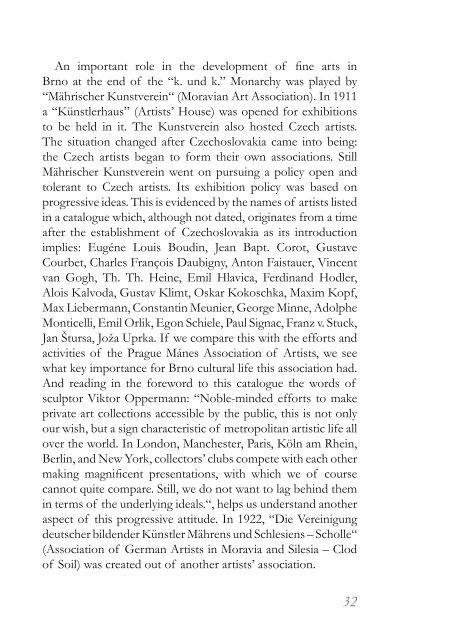Tradice německo-židovské a české kultury v Brně The Tradition of ...
Tradice německo-židovské a české kultury v Brně The Tradition of ...
Tradice německo-židovské a české kultury v Brně The Tradition of ...
Sie wollen auch ein ePaper? Erhöhen Sie die Reichweite Ihrer Titel.
YUMPU macht aus Druck-PDFs automatisch weboptimierte ePaper, die Google liebt.
An important role in the development <strong>of</strong> fine arts in<br />
Brno at the end <strong>of</strong> the “k. und k.” Monarchy was played by<br />
“Mährischer Kunstverein“ (Moravian Art Association). In 1911<br />
a “Künstlerhaus” (Artists’ House) was opened for exhibitions<br />
to be held in it. <strong>The</strong> Kunstverein also hosted Czech artists.<br />
<strong>The</strong> situation changed after Czechoslovakia came into being:<br />
the Czech artists began to form their own associations. Still<br />
Mährischer Kunstverein went on pursuing a policy open and<br />
tolerant to Czech artists. Its exhibition policy was based on<br />
progressive ideas. This is evidenced by the names <strong>of</strong> artists listed<br />
in a catalogue which, although not dated, originates from a time<br />
after the establishment <strong>of</strong> Czechoslovakia as its introduction<br />
implies: Eugéne Louis Boudin, Jean Bapt. Corot, Gustave<br />
Courbet, Charles François Daubigny, Anton Faistauer, Vincent<br />
van Gogh, Th. Th. Heine, Emil Hlavica, Ferdinand Hodler,<br />
Alois Kalvoda, Gustav Klimt, Oskar Kokoschka, Maxim Kopf,<br />
Max Liebermann, Constantin Meunier, George Minne, Adolphe<br />
Monticelli, Emil Orlik, Egon Schiele, Paul Signac, Franz v. Stuck,<br />
Jan Štursa, Joža Uprka. If we compare this with the efforts and<br />
activities <strong>of</strong> the Prague Mánes Association <strong>of</strong> Artists, we see<br />
what key importance for Brno cultural life this association had.<br />
And reading in the foreword to this catalogue the words <strong>of</strong><br />
sculptor Viktor Oppermann: “Noble-minded efforts to make<br />
private art collections accessible by the public, this is not only<br />
our wish, but a sign characteristic <strong>of</strong> metropolitan artistic life all<br />
over the world. In London, Manchester, Paris, Köln am Rhein,<br />
Berlin, and New York, collectors’ clubs compete with each other<br />
making magnificent presentations, with which we <strong>of</strong> course<br />
cannot quite compare. Still, we do not want to lag behind them<br />
in terms <strong>of</strong> the underlying ideals.“, helps us understand another<br />
aspect <strong>of</strong> this progressive attitude. In 1922, “Die Vereinigung<br />
deutscher bildender Künstler Mährens und Schlesiens – Scholle“<br />
(Association <strong>of</strong> German Artists in Moravia and Silesia – Clod<br />
<strong>of</strong> Soil) was created out <strong>of</strong> another artists’ association.<br />
32


